
Balmoral Castle is a large estate house in Royal Deeside, Aberdeenshire, Scotland, owned by Queen Elizabeth II. It is near the village of Crathie, 9 miles west of Ballater and 50 miles west of Aberdeen.

Dufftown is a burgh in Moray, Scotland. While the town is part of the historic Mortlach parish, the town was established and laid out in the early 19th century as part of a planned new town settlement. The town has several listed 19th century buildings and serves as a regional centre for agriculture, tourism and services. The town is well known for its whisky based economy, as it produces more whisky than any other town in Scotland and is home to several existing and former distilleries.
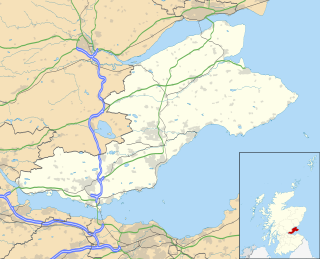
Cupar is a town, former royal burgh and parish in Fife, Scotland. It lies between Dundee and Glenrothes. According to a 2011 population estimate, Cupar had a population around 9,000, making it the ninth largest settlement in Fife, and the civil parish a population of 11,183. It is the historic county town of Fife, although the council now sits at Glenrothes.
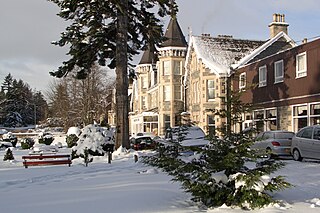
Grantown-on-Spey is a town in the Highland Council Area, historically within the county of Moray. It is located on a low plateau at Freuchie beside the river Spey at the northern edge of the Cairngorm mountains, about 20 miles (32 km) south-east of Inverness.

Skibo Castle is located to the west of Dornoch in the Highland county of Sutherland, Scotland overlooking the Dornoch Firth. Although largely of the 19th century and early 20th century, when it was the home of industrialist Andrew Carnegie, its origins go back much earlier.

Easterhouse is a suburb of Glasgow, Scotland, located on the periphery of the city approximately 6 miles (10 km) east of its centre, partially built on land gained from the county of Lanarkshire as part of a boundary expansion of Glasgow prior to the Second World War. The area is on high ground north of the River Clyde and south of the River Kelvin and Campsie Fells.

The colony houses of Edinburgh were built between 1850 and 1910 as homes for artisans and skilled working-class families by philanthropic model dwellings companies. The first development was the Pilrig Model Buildings, near Leith Walk. Later developments across the city were built by the Edinburgh Cooperative Building Company Limited, founded in 1861. The founders of this company were influenced by the Reverend Dr. James Begg and the Reverend Dr. Thomas Chalmers, ministers of the Free Church of Scotland, who campaigned to improve the housing conditions of the poor.

Torphichen is a historic small village located north of Bathgate in West Lothian, Scotland. The village is approximately 18 miles west of Edinburgh, 7 miles south-east of Falkirk and 4 miles south-west of Linlithgow. The village had a population of 570 in the and a population of 710 in 2016. Torphichen's placename may be Gaelic in origin, e.g., "Tóir Féichín", Tor Fithichean, or Brythonic "tref fechan".

Mar Lodge is a sporting lodge 5 miles to the west of Braemar and the principal building on the Mar Lodge Estate in Aberdeenshire, Scotland. It was built in 1895, replacing an earlier building, by Alexander Duff, 1st Duke of Fife.

Ecclesmachan (NT058736) is an historic village in West Lothian. It lies just north of Uphall on the B8046 road. The village is notable for its medieval origin parish church. As at 2001, the population of the civil parish of Ecclesmachan was 529 and was 811 in 1991.
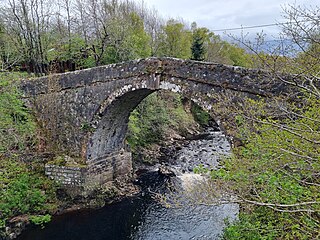
Whitebridge is a small village on the southwest side of Loch Ness in northern Scotland.
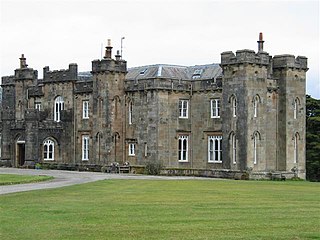
Torrisdale Castle is a historic mansion residence, overlooking Torrisdale Bay, Argyll, south of Carradale, Kintyre, Scotland. The castle is situated at the edge of the village of Torrisdale. It is a category B listed building.
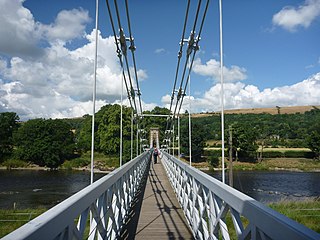
Gattonside is a small village in the Scottish Borders. It is located 1 kilometre (0.62 mi) north of Melrose, on the north side of the River Tweed. In 1143, the lands of Gattonside were granted to the monks of Melrose Abbey by King David I.

Kirkton of Glenisla is a village in Glenisla, Angus, Scotland. It is situated on the River Isla, eleven miles north-west of Kirriemuir and ten miles north of Blairgowrie, on the B951 road. The village consists of a church and graveyard, a hotel, and several holiday cottages. The village is situated adjacent to the 64 mile waymarked Cateran Trail. There is a suspension footbridge that was built in 1824 over the River Isla.

St Vigeans Sculptured Stones Museum, located in the Angus village of St Vigeans, houses an outstanding collection of Pictish carved stones. St Vigeans, close to Arbroath, was the centre of a royal estate in the Early Middle Ages, and was of religious importance as a monastery founded in the 8th century. The present-day St Vigeans Church was built in the 12th century, on a 40-foot (12 m) mound.

Forter Castle is located in Glenisla, Perthshire, Scotland. It was built in 1560 by James Ogilvy, the 5th Lord of Airlie. In 1640, it was burned by Archibald Campbell, the 8th Earl of Argyll, but it was rebuilt in the early 1990s.

Kinnordy House is an estate house near Kirriemuir in Angus, Scotland. The first house was built in the 1680s, when Inverquharity Castle was vacated; however, the current three-storey, towered and turreted structure dates from 1881, incorporating an 18th-century wing and stables. The house was the birthplace of the noted geologist Charles Lyell, and is associated with his friend Charles Darwin.
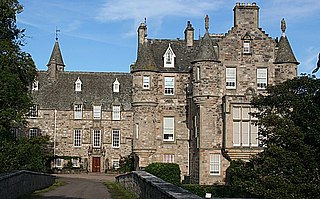
Cullen House is a large house, about 1 kilometre (0.6 mi) south-west of the coastal town of Cullen in Moray, Scotland. It was the seat of the Ogilvies of Findlater, who went on to become the Earls of Findlater and Seafield, and it remained in their family until 1982. Building work started on the house in 1600, incorporating some of the stonework of an earlier building on the site. The house has been extended and remodelled several times by prominent architects such as James Adam, John Adam, and David Bryce. It has been described by the architectural historian Charles McKean as "one of the grandest houses in Scotland" and is designated a Category A listed building. The grounds were enlarged in the 1820s when the entire village of Cullen, save for Cullen Old Church, was demolished to make way for improvements to the grounds by Lewis Grant-Ogilvy, 5th Earl of Seafield; a new village, closer to the coast, was constructed for the inhabitants. Within the grounds are a bridge, a rotunda and a gatehouse, each of which is individually listed as a Category A structure.


















